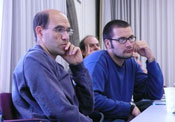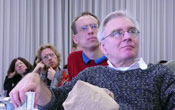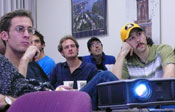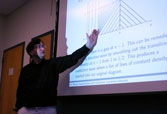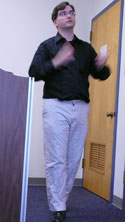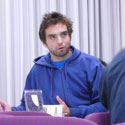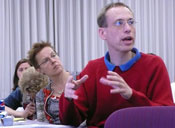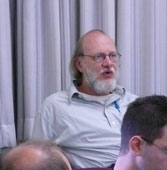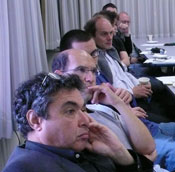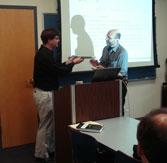
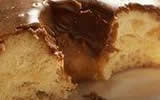
![]()
::: postdoc fellowships
::: senior fellowships
::: resident fellowships
::: associateships
![]()
being here
::: visiting
::: the last donut
::: photo album
::: center home >> being here >> last donut? >> cars |
26 September 2008 The question of how mathematics relates to physical science has long interested scholars. Those outside the physical sciences may well find its fascination with mathematics a tedious fixation to be tolerated politely. Those within the physical sciences easily develop a rapturous obsession with it. Galileo enthused that the Book of Nature "... is written in the language of mathematics, and its characters are triangles, circles, and other geometrical figures, without which it is humanly impossible to understand a single word of it; without these one is wandering about in a dark labyrinth." And this is just one restrained sample of the dewy-eyed adoration mathematics enjoys. Chris Pincock's talk today is on this topic. He originally gave us the title "Mathematics and Scientific Representation." He soon came to sense that this was too big a topic even for a lifetime of scholarship, so, by the time of his talk, the title projected on the screen was a more modest "Abstract Representations and Confirmation." About an hour before the talk, I found Chris and Peter Gildenhuys setting up the digital projector. Chris had a nice handout littered with mathematical equations. I flinched and Chris began to assure me that it wouldn't be that hard. "No fiber bundles," he said; and I knew then that he had my level.
This was the image that everyone watched as they filed in to pick up a bagel or donut and take their seats. The topic, I'd imagined, might be so specialized as not to draw well. That was not the case. The room filled and I noticed quite a few of the philosophers from nearby Carnegie Mellon University had made the trip over Panther Hollow: Teddy Seidenfeld, Jeremy Avigad, Steve Awodey. Chris began by recalling the hymns of praise to mathematics that were sung by some of the greats of our history. While I have long sensed the immense power of mathematical analysis in the physical sciences, I have also long harbored suspicions of the adoration it enjoys. It sometimes seems that it borders on magical thinking. As Chris recalled the hymns, it became noticeable that he was not endorsing them. He was merely displaying them. The recognition slowly dawned that here was a kindred spirit who wanted to understand the great utility of mathematics without resorting to magical thinking. It was now time for Chris to incorporate the circling cars into the talk. He needed an example to make his claims concrete. He'd told me that he'd first played with the case of falling dominos until he found their essential aspects incorporated into a flourishing literature on the mathematics of traffic flow. He began a short tutorial that slowly migrated from traffic talk to a more philosophical discourse, peppered with our terms of art: "representations," "abstractions," "acausal," "causal counterparts," and more. Chris unfolded his story carefully, making all the subtle distinctions he expected he'd need as armor to protect him from the missiles that might come in question time. However the central idea is so clear and simple that it can be stated in a few words.
Then there is a second way. When we mathematize, we can reveal linkages that otherwise might not be apparent. Chris illustrated the point with his traffic model. Described mathematically, the cars traveling on a road are like molecules of a fluid flowing in a pipe. One can now look for the sort of processes that are familiar to us in fluids. Chris started showing us traffic models in which there were waves of rarefaction and shock waves. The latter, he noted with some satisfaction, are traffic jams! Mathematics makes it possible for us to connect these otherwise disparate systems. What we learn of one can be transferred over to the other. All this seemed just right to me. What was especially appealing is that Chris was introducing what is most distinctive about science. It is a body of claims about the world that we have strong reason to believe because it has gone through the most rigorous confirmation-- or at least should have when things are going well. So here was a deflationary story about the utility of mathematics in science that connects the mathematics directly with that distinctive feature of science. There was no magical thinking here; just good common sense. And that is just what I told Chris in question time. It took me a while to get there. The talk had provoked a lot of thoughts and, as chair, I was only able to insert myself as seventh in line. Chris earned his umbrella. John D. Norton Lunchtime Talk |
 Turning to the screen, I saw he had a curious movie running of cars driving on a circular track. At first I thought it was a simulation, but, on closer inspection it looked like the real thing.
Turning to the screen, I saw he had a curious movie running of cars driving on a circular track. At first I thought it was a simulation, but, on closer inspection it looked like the real thing. 


